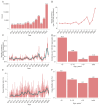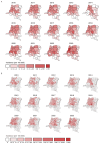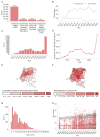Suspected and confirmed mpox cases in DR Congo: a retrospective analysis of national epidemiological and laboratory surveillance data, 2010-23
- PMID: 39892912
- PMCID: PMC7618260
- DOI: 10.1016/S0140-6736(24)02669-2
Suspected and confirmed mpox cases in DR Congo: a retrospective analysis of national epidemiological and laboratory surveillance data, 2010-23
Abstract
Background: DR Congo has the highest global burden of mpox, a disease caused by infection with the monkeypox virus. The incidence has risen since 1980, but recent analyses of epidemiological trends are lacking. We aimed to describe trends in suspected and confirmed mpox cases in DR Congo using epidemiological and laboratory mpox surveillance data collected from 2010 to 2023, and provide insights that can better inform the targeting and monitoring of control strategies.
Methods: We analysed aggregated national epidemiological surveillance data and individual-level laboratory data from 2010 to 2023. We calculated incidence based on suspected cases, case-fatality ratios, and percentage of laboratory-confirmed cases and assessed geospatial trends. Demographic and seasonal trends were investigated using generalised additive mixed models.
Findings: Between Jan 1, 2010, and Dec 31, 2023, a total of 60 967 suspected cases and 1798 suspected deaths from mpox were reported in DR Congo (case-fatality ratio 2·9%). The number of reporting provinces increased from 18 of 26 provinces in 2010 to 24 of 26 provinces in 2023. The annual incidence increased from 2·97 per 100 000 in 2010 to 11·46 per 100 000 in 2023. The highest incidence (46·38 per 100 000) and case-fatality ratio (6·0%) were observed in children younger than 5 years. Incidence was higher in rural compared with urban areas. PCR testing was performed for 7438 suspected cases (12·2%), with 4248 (57·1%) of 7438 samples testing positive. Median age of confirmed cases (13·0 years [IQR 6·0-25·0]) remained stable, although the 95th percentile of age increased over time.
Interpretation: The incidence and geographical distribution of suspected mpox cases have increased substantially since 2010. Improvements in surveillance and decentralised testing are essential to monitor mpox trends and direct interventions effectively, to address the public health emergency declarations issued in August, 2024.
Funding: Belgian Directorate-General Development Cooperation and Humanitarian Aid; European and Developing Countries Clinical Trials Partnership; Research Foundation-Flanders; European Civil Protection and Humanitarian Aid Operations; Department of Economy, Science, and Innovation of the Flemish Government; Canadian Institutes of Health Research; and the International Development Research Centre.
Copyright © 2025 Elsevier Ltd. All rights reserved, including those for text and data mining, AI training, and similar technologies.
Conflict of interest statement
Declaration of interests LL has received institutional consultancy fees from BioNtech and institutional research funding from Sanofi, both not relevant for this work. JKi has provided expert witness reports for the Treasury Board of Canada not relevant to this work. JKi has also received mpox research funding from the Canadian Institutes of Health Research and the International Development Research Centre in open funding competitions. All other authors declare no competing interests.
Figures






Comment in
-
Rising mpox trends in DR Congo: the neglected spread of an epidemic.Lancet. 2025 Feb 1;405(10476):358-360. doi: 10.1016/S0140-6736(25)00137-0. Lancet. 2025. PMID: 39892895 No abstract available.
References
Publication types
MeSH terms
Grants and funding
LinkOut - more resources
Full Text Sources
Research Materials

